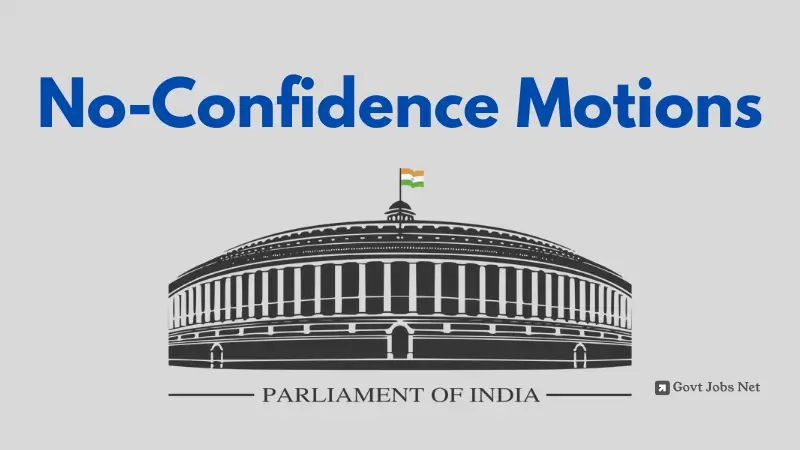
A No-Confidence Motion (NCM) is a significant tool in the Indian parliamentary system. It allows members of the Lok Sabha to question the legitimacy of the ruling government. If the motion is passed, the government is obliged to resign.
What is a No-Confidence Motion?
A no-confidence motion is a formal proposal moved in the Lok Sabha stating that the House no longer has confidence in the Council of Ministers.
- If the motion is passed by a simple majority of members present and voting, the government is bound to resign.
- It is not mentioned directly in the Constitution, but derives its authority from Rules of Procedure and Conduct of Business in Lok Sabha (Rule 198).
As of April 2025, a total of 27 no-confidence motions have been introduced in the Lok Sabha since independence.
Procedure for Passing a No-Confidence Motion
Here is the step-by-step process followed in the Lok Sabha:
1. Notice
- Any member of the Lok Sabha can submit a written notice to the Speaker.
- The content of the motion must state:
“This House has no confidence in the Council of Ministers.”
2. Support of 50 Members
- The Speaker of the Lok Sabha examines the notice for admissibility under Rule 198 of the Rules of Procedure and Conduct of Business.
- A No-Confidence Motion is admitted only if at least 50 MPs support it by rising in their seats when asked by the Speaker.
3. Speaker’s Decision
- If admitted, the Speaker allots a date for discussion and voting.
- The debate must be held within 10 days of admission.
4. Debate in the Lok Sabha
- MPs debate the motion, allowing the opposition to raise concerns and the ruling government to defend its position.
- The Prime Minister or a senior Cabinet minister usually gives the concluding reply on behalf of the government.
5. Voting on the Motion
- After the debate, the Speaker calls for a vote.
- Voting is usually done by voice vote, or if demanded, through division (electronic voting or physical count).
6. Outcome of the Vote
- If the motion is passed (i.e., a majority of members present and voting support it), the government is constitutionally required to resign.
- If the motion is defeated, the government continues to hold office.
Key Points:
- Only the Lok Sabha can entertain a No-Confidence Motion, not the Rajya Sabha.
- There is no need to state specific reasons in the motion.
- There is no limit on how many times such a motion can be moved.
Features of a No-Confidence Motion
- Only in Lok Sabha
A no-confidence motion can only be introduced and passed in the Lok Sabha, not in the Rajya Sabha, because the Council of Ministers is collectively responsible to the Lok Sabha. - Requires Minimum Support to Admit
It must have the support of at least 50 members of the Lok Sabha to be accepted for discussion by the Speaker. - Simple Majority Needed to Pass
The motion is passed if a simple majority (more members in favour than against) of those present and voting supports it. - Can Be Introduced by Any Member
Any Lok Sabha member (from opposition or ruling party) can introduce a no-confidence motion. - No Need to State Reasons
The motion does not require the member to state specific reasons for introducing it. - Time-Bound Discussion
Once admitted, the Speaker allots time for discussion, and a vote must be conducted within 10 days. - Result Leads to Government Resignation
If passed, the entire Council of Ministers, including the Prime Minister, is obliged to resign. - Can Be Moved Anytime
There is no specific timing or frequency limit mentioned in the Constitution; it can be moved at any time when the House is in session. - Constitutional and Political Tool
It acts as a powerful instrument of accountability, allowing the legislature to express loss of confidence in the government. - Not Allowed During Budget Session Debate
The Speaker may disallow the motion during the budget discussion or when other substantive business is ongoing.
Timeline of Major No-Confidence Motions in Indian History
1. 1963 – First No-Confidence Motion
- Target: Prime Minister Jawaharlal Nehru
- Context: India’s defeat in the 1962 Indo-China war
- Moved By: Acharya Kripalani
- Outcome: Defeated
- Remarks: First such motion after independence; over 40 MPs participated in a 40-hour-long debate.
2. 1979 – Only Successful No-Confidence Motion
- Target: Prime Minister Morarji Desai
- Context: Political instability within the Janata Party coalition
- Moved By: Y.B. Chavan (Congress)
- Outcome: Morarji Desai resigned before the vote
- Remarks: Only successful no-confidence motion in Indian history.
3. 1980 – Motion Against Indira Gandhi
- Target: Prime Minister Indira Gandhi
- Context: Return to power post-Emergency; opposition questioned her policies
- Outcome: Defeated
- Remarks: Showed the opposition’s revival after the Emergency period.
4. 1993 – P.V. Narasimha Rao Survives
- Target: Prime Minister P.V. Narasimha Rao
- Context: BJP withdrew support; Congress faced internal turmoil
- Outcome: Government survived by a vote of 265–251
- Remarks: Later involved in a scandal (JMM bribery case) alleging MPs were bribed to vote in favour of the government.
5. 1999 – Vajpayee Government Falls
- Target: Prime Minister Atal Bihari Vajpayee
- Context: AIADMK (led by Jayalalithaa) withdrew support
- Outcome: Lost by 1 vote (269–270)
- Remarks: Led to early elections; one of the closest calls in Indian parliamentary history.
6. 2003 – Vajpayee Survives Again
- Target: Prime Minister Atal Bihari Vajpayee
- Context: Opposition raised issues like the Tehelka scam and Gujarat riots
- Outcome: Defeated
- Remarks: Motion helped the government demonstrate its strength ahead of 2004 elections.
7. 2008 – Manmohan Singh Over Nuclear Deal
- Target: Prime Minister Dr. Manmohan Singh
- Context: Left Front withdrew support over the Indo-US nuclear deal
- Outcome: Government survived with 275 votes in favour and 256 against
- Remarks: Motion led to major political drama including a cash-for-votes controversy.
8. 2018 – Modi Government’s First No-Confidence Motion
- Target: Prime Minister Narendra Modi
- Context: TDP (Telugu Desam Party) moved the motion over special status for Andhra Pradesh
- Outcome: Defeated (325 votes against, 126 in favour)
- Remarks: Rahul Gandhi’s surprise hug to the PM and subsequent wink became a talking point.
9. 2023 – Modi Government Faces Motion Over Manipur Violence
- Target: Prime Minister Narendra Modi
- Context: Opposition (INDIA alliance) moved motion demanding accountability for violence in Manipur
- Outcome: Defeated after a long debate
- Remarks: Symbolic motion aimed at forcing the Prime Minister to speak on the issue; PM replied at the end of the debate.
✅ Read our comprehensive guide on Biochemical Oxygen Demand (BOD) – Definition, Importance & BOD5 Test to understand how BOD affects water quality and competitive exam preparation.
Summary of Major No-Confidence Motions
| Year | Prime Minister | Outcome | Key Issue |
|---|---|---|---|
| 1963 | Jawaharlal Nehru | Defeated | 1962 India-China War |
| 1979 | Morarji Desai | Resigned | Janata Party collapse |
| 1993 | P.V. Narasimha Rao | Defeated | JMM Bribery and withdrawal of support |
| 1999 | Atal Bihari Vajpayee | Lost by 1 vote | AIADMK withdrew support |
| 2008 | Manmohan Singh | Defeated | Indo-US Nuclear Deal |
| 2018 | Narendra Modi | Defeated | Andhra Pradesh special status demand |
| 2023 | Narendra Modi | Defeated | Manipur violence issue |
No-confidence motions are a vital part of India’s democratic process. Even when not successful, they:
- Spark national debate
- Hold the government accountable
- Reflect changing political alliances
They remain one of the most important mechanisms in ensuring transparency, debate, and democratic integrity in Indian governance.
For official information on parliamentary procedures, refer to the Lok Sabha Rules of Procedure from the Lok Sabha Secretariat.
👉 Prepare smarter for competitive exams with this detailed vitamins guide covering sources, functions & deficiency diseases.
FAQs on No-Confidence Motion in Lok Sabha
What is a No-Confidence Motion?
A: A No-Confidence Motion is a parliamentary motion moved in the Lok Sabha stating that the House no longer has confidence in the Council of Ministers. If passed by a majority, the government must resign.
Who can move a No-Confidence Motion in India?
A: Any member of the Lok Sabha can move a No-Confidence Motion by giving written notice. For the motion to be accepted for discussion, it must be supported by at least 50 other members.
How many No-Confidence Motions have been introduced in the Lok Sabha so far?
A: As of May 2025, a total of 27 No-Confidence Motions have been introduced in the Lok Sabha since independence.
Has any No-Confidence Motion ever succeeded in India?
A: Yes, only one motion succeeded — in 1979, against the Morarji Desai government, which led to his resignation before the vote.
Can the Rajya Sabha entertain a No-Confidence Motion?
A: No. A No-Confidence Motion can only be introduced and voted upon in the Lok Sabha, since it is the directly elected house of the people.
What happens if a No-Confidence Motion is passed?
A: If the motion is passed by a simple majority of Lok Sabha members present and voting, the entire Council of Ministers, including the Prime Minister, must resign.
Also read:
- Complete guide on Vitamins – their sources, benefits, and deficiency diseases.
- Learn about Biochemical Oxygen Demand (BOD) with our comprehensive guide
- Detailed guide on the Eighth Schedule and language recognition in India
Click here to read

Ameer M, founder of GovtJobsNet.com, helps job seekers with accurate govt job updates and exam tips. | அரசு வேலை வழிகாட்டி, நம்பகமான தகவல்களை வழங்குபவர்.